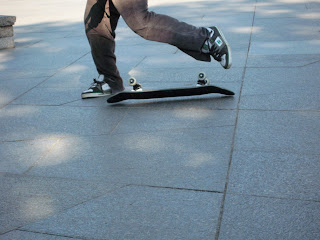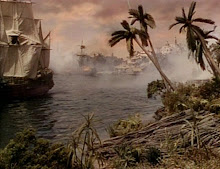Letna Hill

There are two tourist guides that I use in all my tourist activities here in Prague, as I hope this will enable a more essential–vertical in time- understanding of the evident scenery of the city. The 1st guide is a rather recent publication and was given to me by Honza (as he went to the countryside for a few days and was feeling rather guilty for having deprived me of his services as my local guide). I found the second guide in Ms Vladimira's house; it was published in 1973 and it includes a welcome to the guests to the "most beautiful part of Czechoslovakia, the city of Prague"…
As both of them address international tourists, it is rather difficult for a person to accept that they do actually refer to the same city.
Today my two guides took me up to Letna Hill, one of the mounds of Prague that offer an impressive view to the river Vltava and to the old city. The topography and organization of the hill (which nowadays functions as a park where locals engage in several activities, and which hosts many restaurants that are often visited by tourists) grants you some sort of awkward self-consciousness from the very first moment. One's body is found penned in an extraordinarily structured landscape whose "structure" is not derived from clearly urban planning intentions but is rather manifested as the effect of a series of reorganizations (and of the decision made to carry them out in a chain….in this single landscape)! So, as soon as you turn your back to the old town and decide to enter into the survey of the complex century from which you have just stepped out, you need to first clarify you odd relation to the scale. That is not to say with the scale that is evidently manifested before your eyes, but with the scale that has evidently been removed. It becomes clear from the very first moment that what is important about this landscape is that which is not visible (not any more).
 The largest group statue in Europe, measuring 15.5 metere in height and 22 meters in length and weighing 17000 tons, was once revealed on this hill – on the huge marble pedestal, which is rescued up to this day. The monument honoring Joseph Vissarionovich Stalin depicts the Soviet leader amidst a crowd of workers. It took Sculptor Otakar Svec and 600 workers 6years of all-day work to complete this work, which is accompanied by series of dark details/coincidences (as for example that Otakar Svec committed suicide the day before the statue reveal and that suicides of others who were also related to the history of the monument followed). The monument was never welcomed by the city. Its completion coincided with the period of de-Stalinization and amounted to shame for the Communist Party of Czechoslovakia until 1962 when after the suggestion of the Soviet Union 800kg of dynamite were used to destroy it.
The largest group statue in Europe, measuring 15.5 metere in height and 22 meters in length and weighing 17000 tons, was once revealed on this hill – on the huge marble pedestal, which is rescued up to this day. The monument honoring Joseph Vissarionovich Stalin depicts the Soviet leader amidst a crowd of workers. It took Sculptor Otakar Svec and 600 workers 6years of all-day work to complete this work, which is accompanied by series of dark details/coincidences (as for example that Otakar Svec committed suicide the day before the statue reveal and that suicides of others who were also related to the history of the monument followed). The monument was never welcomed by the city. Its completion coincided with the period of de-Stalinization and amounted to shame for the Communist Party of Czechoslovakia until 1962 when after the suggestion of the Soviet Union 800kg of dynamite were used to destroy it.
From 1991 onwards, there exists a meager metronome on the same spot, verifying thus the increasing function of time, which cannot however hamper a series of natural regressions in this intense, in terms of rethinking,piece of earth.
A signboard on the foundation of the metronome says: "The Metronome, the work
of sculptor Vratislav Novák was erected in 1991 atop the
massive stone plinth that originally served as the base for the
monument to Soviet leader Josef Vissarionovich Stalin. Work began on
Prague's Stalin monument towards the end of 1949, and in May 1955, it
was finally unveiled. The largest group sculpture in Europe during its
existence, the monument had a reinforced-concrete structure faced with
235 granite blocks, weighing 17,000 tonnes and costing 140 million
crowns to complete. The gigantic composition, by sculptor Otakar Švec
and the architects Jiří and Vlasta (his wife) Štursa, did not tower
for long over the medieval center of Prague: in connection with Soviet
criticism of Stalin's "cult of personality," the work was dynamited
and removed towards the end of 1962."
 After the removal of the Stalin monument the empty space of the pedestal was used for a series of historically contradictory functions, the most extreme being the erection of the 35meter long statue of Michael Jackson during his "History" European tour, an act in response to the importance of the historicity, but also in confirmation of its end. Moments of analogous manifestation may also be documented in the filming of the epic Michael Jackson concert in Bucharest.
Nowadays the empty space has found a natural functionality which seems to be an even greater orchestrated underlining of the obvious than the Michael Jackson marketing center intention. The pedestal now functions as the point where local skateboarders practice on a daily basis in an endless –identical rhythm and an impressive space organization that reminds of a choreography. With the basic motives being fall and recovery, virtuosity, failure but also accomplishment, the whole activity could be understood as a metaphor on history and as the resolution of a different (his)story in this so 'heavy' square piece of earth.
After the removal of the Stalin monument the empty space of the pedestal was used for a series of historically contradictory functions, the most extreme being the erection of the 35meter long statue of Michael Jackson during his "History" European tour, an act in response to the importance of the historicity, but also in confirmation of its end. Moments of analogous manifestation may also be documented in the filming of the epic Michael Jackson concert in Bucharest.
Nowadays the empty space has found a natural functionality which seems to be an even greater orchestrated underlining of the obvious than the Michael Jackson marketing center intention. The pedestal now functions as the point where local skateboarders practice on a daily basis in an endless –identical rhythm and an impressive space organization that reminds of a choreography. With the basic motives being fall and recovery, virtuosity, failure but also accomplishment, the whole activity could be understood as a metaphor on history and as the resolution of a different (his)story in this so 'heavy' square piece of earth.






No comments:
Post a Comment